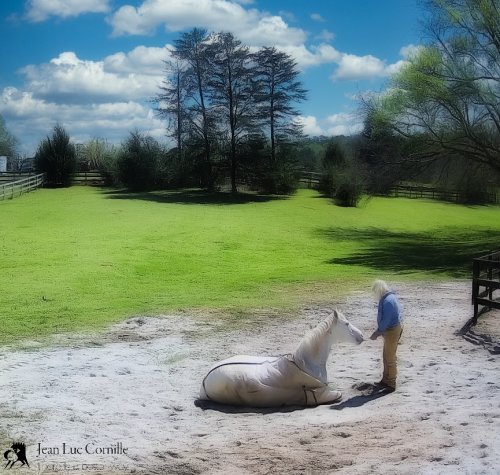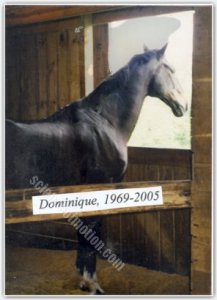Equine Functional Ability
Equine
Functional instability

Weeks ago, senators warned their friends of the gravity of the coronavirus and potential crash of Wall Street so that they can save their money. Meanwhile, peoples die due to a lack of preparation and supply. I guess in modern days this is called business. There is a fundamental functional instability in human thinking.
"A functional instability refers to a situation where muscles and other restraining soft tissues are not providing appropriate resistance to movement for a given joint. This is thought to occur in the equine SIJ." (L.M. Goff, L.B. Jeffcott, J. Jasiewicz, C.M.McGowan. Structural and biomechanical aspects of equine sacroiliac joint function and their relationship to clinical disease. The Veterinary Journal 176 (2008, 281-29)
The quote can be extended far beyond the horse's sacroiliac joint. When ethics, empathy, decency, and honesty are lacking, there is severe instability in human thinking. The whole thoracolumbar spine and indeed the horse's entire physique functions as a unit exposing the archaism of the equitation of body parts, the correct aids, as well as the therapies of body parts. Cutting the supraspinous ligament might, theoretically, ease the proximity of one two or three dorsal spines, kissing spine), but at the risk of altering the stability of the whole thoracolumbar column. This is as dumb as saving Wall Street and letting peoples die. Workers are the stone base of the American body, and until they can be replaced by robots, which is the aim of the ones owning the leadership, it might be premature to commence the extinction of the lower classes.
In the human as well as equine body, muscles are doing the work, but muscles don't work alone. Muscles do much more than create the forces needed to extend and flex joints, which is what has been traditionally taught in anatomy courses. Muscle ensure tension and function of the fascia. Muscles absorb forces, maximize the elastic strain energy of the tendons and aponeurosis. "Most of the length change required for the work of locomotion occurs not in the muscle fibers themselves but by elastic recoil of the associated tendons and muscles aponeurosis." (The role of the extrinsic thoracic limb muscles in equine locomotion. R. C. Payne, P. Veenman, and A. M. Wilson. J. Anat. (2005) 206, pp 193-404).
Just in a matter of weeks of reduced human pollution, nature is coming back to life. Venice canals are clear. The planet and animals will happily survive human extinction, but animals would, as happily, live with us if we could take conscience and correct our functional instability. Errors are typical components of the learning process, rider errors, horse errors. Dysfunctional thinking, which is, in fact, directed by business, places a pang of guilt on mistakes. The ludicrous theory that if we apply the aids correctly, the horse will execute the move flawlessly is a business strategy encouraging us to look in manipulations and syringes for a solution that, in most instances, we have the potential to resolve.
Instead of waiting until the horse understands the aids, as classical equitation suggests, we can upgrade our equitation of gestures and body parts to a conversation creating, through the horse's mental processing, coordination of the horse physique efficiently adapted to the effort. Instead of injecting the hocks, the science of motion identifies and corrects the source of the kinematics abnormality stressing the hock. This is basically proper training; protecting the joints from aberrant stress and consequent pathological damages.
Before developing navicular syndrome.  Dominique was unable to perform tempi-changes. He was able to execute a series of three or four changes and needed a few strides to reorganize himself before another round of three or four changes. Dominique was basically a "would be" Grand Prix dressage horse. The dysfunction altering the performance was the dysfunction, which later caused the development of the navicular syndrome. We corrected the dysfunction, and Dominique gradually regained soundness.
Dominique was unable to perform tempi-changes. He was able to execute a series of three or four changes and needed a few strides to reorganize himself before another round of three or four changes. Dominique was basically a "would be" Grand Prix dressage horse. The dysfunction altering the performance was the dysfunction, which later caused the development of the navicular syndrome. We corrected the dysfunction, and Dominique gradually regained soundness.
It was done in hand at first as Dominique was too lame to carry a rider, and, as the remodeling process progressed, riding became possible. Dominique regained soundness and gradually became capable of practicing high-level movements. When I asked for the tempi changes, Dominique executed the whole series non-stop. The thoracic spine dysfunction that loaded the right front leg causing abnormal stress on the distal sesamoid bone was the thoracic spine dysfunction that hampered the horse's ability to perform tempi-changes.
Of course, the equestrian leadership refused the facts, Dominique was sound, performing high-level movements better than before the navicular syndrome issue, but the approach did not fit the paradigm. We replaced the corrective shoeing with correct shoeing, and we corrected the kinematics abnormality from its source, which was a dysfunction of the thoracic spine. Instead of stimulating interest, as one would imagine considering the large number of horses put to sleep because of navicular syndrome, we meet resistance and anger. The results were undisputable but the audace of questioning the paradigm too pertinent. How dare could we explore the thought that thoracolumbar dysfunction could be the root cause of limb kinematics abnormality when the norm is that limb kinematics abnormalities create spine dysfunction. How dare could we look higher than the corrective shoeing and restore soundness to seventeen cases of navicular syndrome by addressing and correcting the back dysfunction. The back dysfunction was the cause of the kinematic abnormality inducing excessive stress on the deep digital flexor tendon and distal sesamoid bone We corrected the back dysfunction and proper limb kinematics was restored. Albert Einstein warned against the society of faithful servants, killing the sacred gift of our mind, which is intuition. How dare could we look beyond been a faithful servant and refining our intuitive mind with knowledge.
Intuition is not infallible and needs to be supported with extensive knowledge. "The good news is that the moment you decide that what you know is more important than what you have been taught to believe, you will have shifted gears in your quest for abundance. Success comes from within, not from without." (Ralf Waldo Emerson) The bad news is that success will not come as long as we believe that we know more than we know. "Between stimulus and response, there is a space… In that space is our power to choose our response. In our response, lies our growth and our freedom." (Viktor Frankl) The space between stimulus and response is the equestrian art, which includes the horse's soundness. The horse's response is influenced by his willingness but also his survival instinct protecting whatever muscle imbalance or other issues altering the excellence of the performance. The space is where the conversation occurs between our understanding of the performance's athletic demand and the difficulty described by the horse.
The horse is willing to explore if our insights guide him toward ease and effortlessness. The efficiency of our analysis rests on our knowledge. In the following weeks, the science of motion is going to publish "another" study of half-pass. "Half-Pass a Dynamic Perspective." The dynamic perspective is indeed, a revolution. Half-pass is a powerful and efficient gymnastic exercise but for different reasons than the ones emphasized in the lines and between the lines of traditional equitation. Each combination of limbs sequences induces various forces that the horse has to manage to keep lateral bending and adequate rotation while moving his body in the direction of the movement. This is the knowledge that allows our intuitive mind to be a sacred gift.
Jean Luc


